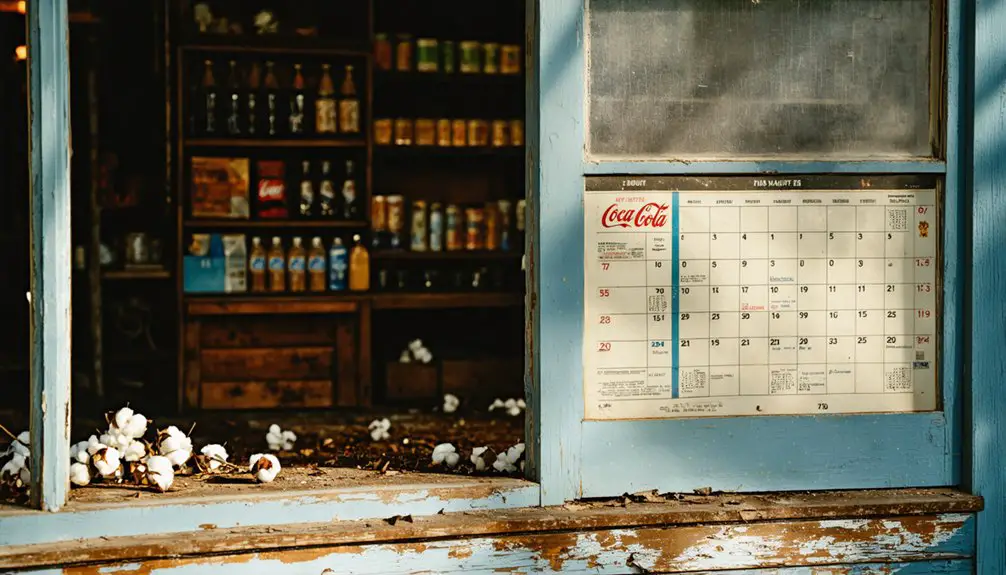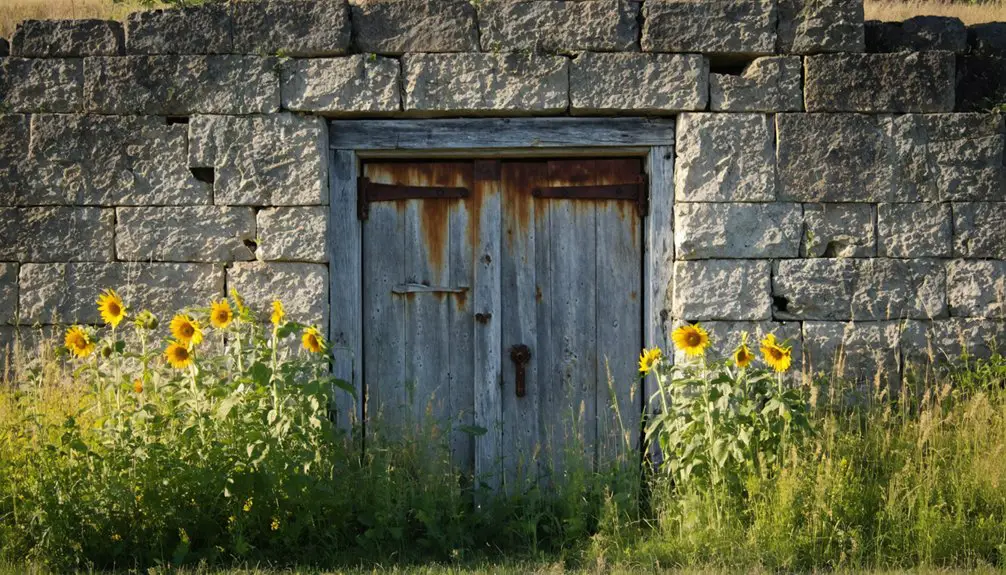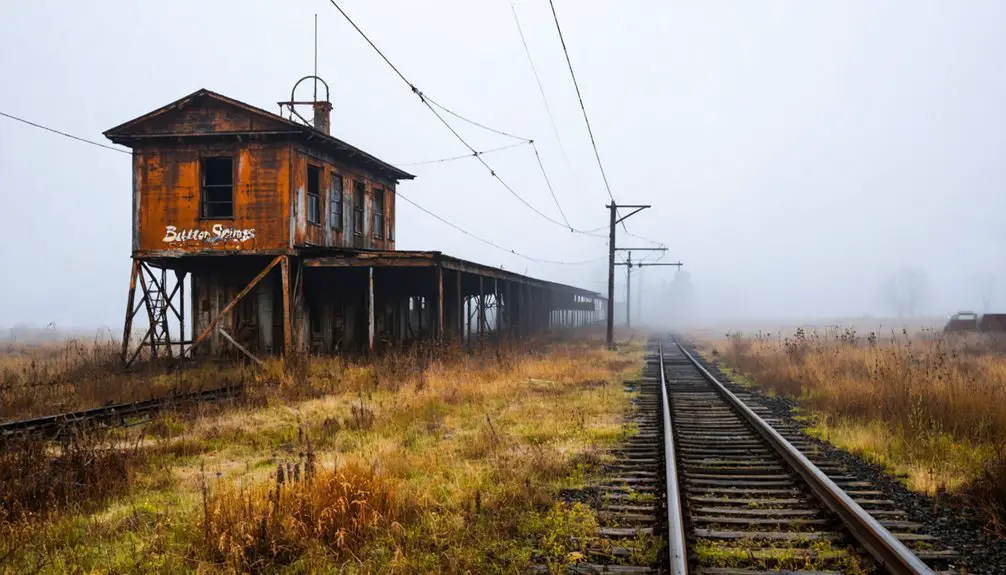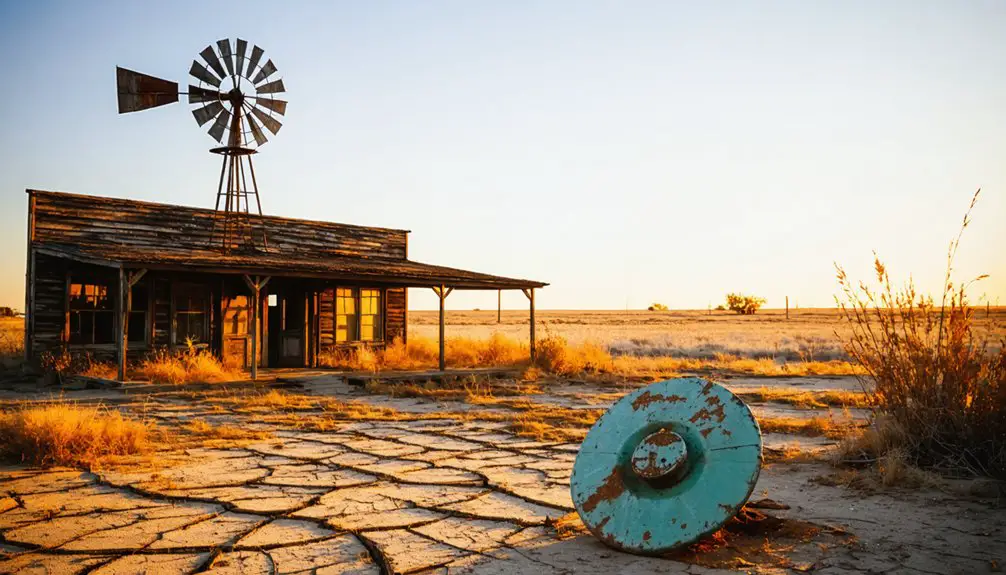You’ll find Button Springs among Oklahoma’s most fascinating ghost towns, situated in Alfalfa County near the Cherokee Strip. This pioneering community emerged around natural springs and railroad lines, focusing on wheat cultivation and livestock. In 1888, the settlement relocated and became Wapanucka, honoring Delaware Indian heritage. While abandoned buildings and a cemetery now mark its location, Button Springs’ rich history of cultural exchange, local legends, and archaeological discoveries awaits exploration.
Key Takeaways
- Button Springs began as a small Oklahoma community near railroad lines, focused on wheat cultivation and livestock raising before becoming a ghost town.
- The settlement’s name came from a natural spring and nearby button-shaped geographic feature that served as vital water sources.
- Economic decline occurred due to railroad route changes, depleted oil wells, exhausted cotton fields, and the inability to compete with mechanized farming.
- Archaeological findings include prehistoric artifacts, Plains Village era remains, and a Euro-American button marking cultural transitions in the region.
- The ghost town features weathered school buildings, abandoned business structures, and a cemetery preserving early settler history.
Origins and Early Settlement
When Oklahoma was still largely unsettled territory, Button Springs emerged as a small community in what would become Alfalfa County, strategically positioned near railroad lines and fertile agricultural land.
You’ll find its roots tied to the Cherokee Nation’s land leases, where early settlers faced significant settlement challenges while establishing their homesteads.
These pioneering families showed remarkable community resilience as they built their lives around the local springs, which provided essential water for both domestic and farming needs. Like many of Oklahoma’s estimated two thousand ghost towns, Button Springs would eventually face decline and abandonment.
They primarily focused on wheat cultivation and livestock raising, taking advantage of the rolling plains.
Despite harsh weather conditions and initial isolation, they established the foundations of community life, including schoolhouses and churches, creating a support network that helped them overcome the frontier’s demanding circumstances.
Similar to other communities like Burke City, the settlement’s vulnerability to natural disasters would later contribute to its eventual decline.
The Mystery of Button Springs’ Name
How Button Springs earned its distinctive name remains one of the settlement’s most intriguing mysteries. While several name theories exist, the most likely explanation points to a natural spring that served as an essential water source for early inhabitants.
Similar to Dunton Hot Springs, the natural springs in Button Springs drew settlers to the area for their healing properties. You’ll find that some locals believe the name reflects a button-shaped geographic feature near the spring, while others suggest it derives from an early settler or indigenous term.
Like many Oklahoma towns, Button Springs saw significant growth when the railroad arrived in the region. The name’s cultural significance runs deep, as the spring played a key role in the community’s development. Like many frontier settlements, Button Springs likely earned its name from a distinctive physical characteristic that helped travelers and residents identify the location.
Despite extensive research, no definitive historical records confirm the exact origin, adding to the ghost town’s mystique.
Relocation and Transformation to Wapanukca
You’ll find that Button Springs’ most significant transformation occurred in 1888 when its post office relocated four miles east, anticipating the railroad construction between Haileyville and Ardmore.
The community’s shift aligned with broader regional changes, as the St. Louis, Oklahoma and Southern Railway’s construction in 1900-1901 drew settlers toward what would become Wapanucka. The Rock Academy building had already established historical importance in the area as a school and Civil War hospital.
The name change to Wapanucka honored the Delaware Indians and the nearby creek, reflecting the area’s deep connection to Native American heritage and its evolution into a transportation hub. By 1907, the growing town reached a population of 789 at statehood, marking its successful transition from Button Springs.
Community Migration Details
The transformation of Button Springs into Wapanucka began in 1888, as the anticipation of a new railroad line between Haileyville and Ardmore prompted the community’s post office to relocate four miles east. This move reflected broader community dynamics that prioritized rail access and economic opportunity. The Wapanucka World documented these changes through detailed coverage of local developments.
You’ll find that several factors influenced these migration trends. The Wapanucka Female Manual Labour School had already established a strong community foundation in the area. State Highway 22 and other major roadways would eventually connect through the region, further enhancing transportation access.
When multiple rail lines, including the St. Louis, Oklahoma and Southern Railway, chose routes through the region, they created a powerful draw. The town’s position at the crossroads of State Highways 7 and 48 sealed its fate as a regional hub, while access to natural springs and expanding transportation networks made Wapanucka an increasingly attractive settlement choice.
Name Change Significance
While Button Springs operated as a small frontier settlement, its transformation into Wapanucka in 1888 carried deep cultural significance rooted in Delaware Indian heritage.
You’ll find the name “Wapanucka” means “Eastern Land People” in the Delaware language, honoring the tribe’s presence in the region before the Civil War.
The name change represented more than just a physical move – it marked a shift from settler-focused identity to one embracing indigenous heritage.
When the post office relocated four miles east to meet the expanding railroad, the community seized the opportunity to establish a stronger cultural identity.
Like the historic Battle of Cabin Creek site, the area played a role in territorial conflicts between Union and Confederate forces.
The 4WD required roads leading to the original Button Springs site serve as a reminder of its remote frontier origins.
The name’s connection to the Delaware Nation, along with the nearby Wapanucka Creek and Academy, helped preserve the area’s rich indigenous heritage while positioning the town for future growth.
Life in Early Oklahoma Territory
As settlers flooded into Oklahoma Territory during the 1889 Land Run, life quickly transformed from an unorganized frontier into bustling communities filled with determined homesteaders.
You’d have found yourself among a remarkable frontier diversity of neighbors – European-American farmers, freedmen, traders, and Native Americans all seeking opportunity in this new land.
You’d have faced considerable agricultural challenges while building your homestead. Starting with just a tent for shelter, you’d work the land during scorching days, adapting crops to local soil conditions.
In newly established towns like Oklahoma City and Guthrie, you’d join other settlers in building schools, churches, and businesses.
Without formal government until 1890, you’d navigate land disputes and claim conflicts through provisional town councils, working to establish order in your growing community.
Economic Forces Behind the Town’s Decline

The shift of railroad routes away from Button Springs and other agricultural towns in Oklahoma proved devastating as you’d have seen businesses lose essential shipping access and market connections.
You’ll notice this transportation change coincided with plummeting crop prices and the oil industry’s collapse, creating a perfect storm that crippled the local economy.
Your small farming community watched helplessly as depleted oil wells and exhausted cotton fields eliminated the resource-based jobs that had sustained multiple generations of Button Springs families.
Railroad Routes Changed Direction
Railroad route changes dealt a devastating blow to Button Springs’ survival in the early 20th century. As railway evolution shifted toward more direct mainline routes, major carriers like Missouri-Kansas-Texas and St. Louis-San Francisco optimized their operations to connect larger industrial hubs.
You’ll find this transportation history marked a turning point for the town’s decline, as its crucial branch line was eventually abandoned.
The impact rippled through the community when railroads focused on profitable long-distance freight routes instead of local service. Without rail access, Button Springs’ businesses faced higher shipping costs, and industries dependent on rail transport either closed or relocated.
What you’re seeing is how strategic route consolidations by larger railroad corporations effectively isolated the town, cutting off its economic lifeline.
Agricultural Market Forces Shifted
Dramatic shifts in agricultural market forces reshaped Button Springs’ economic landscape during the early 20th century.
You’d have seen local farmers struggling to adapt as cotton’s dominance gave way to wheat and corn production. The town’s smaller farms couldn’t keep pace with mechanization trends that favored larger operations with capital for expensive equipment.
While crop rotation between cotton, wheat, and corn could’ve helped maintain soil health, market pressures pushed farmers toward specialization.
You’d have noticed fewer farmhands needed as tractors replaced horse-drawn plows, especially after World War I when labor shortages accelerated mechanization.
The economics simply didn’t work for Button Springs’ family farms – they couldn’t compete with larger operations that achieved better yields through mechanized farming, ultimately contributing to the town’s decline.
Resource Depletion Impact Pattern
Beyond agricultural changes, resource depletion emerged as a major force behind Button Springs’ downward spiral. Poor resource management and lack of economic sustainability created a devastating chain reaction that ultimately sealed the town’s fate.
You’ll recognize three key patterns that defined Button Springs’ decline:
- Natural resources exhausted without replacement strategies, destroying the town’s economic foundation.
- Local businesses shuttered as the consumer base shrank, creating a downward economic spiral.
- Limited transportation access isolated the community from essential trade networks.
The town’s inability to diversify its economy left it vulnerable when primary resources ran out. Without new industries to maintain jobs and commerce, residents were forced to seek opportunities elsewhere, leading to the inevitable ghost town status Button Springs would later achieve.
Historical Landmarks and Remnants

The scattered remains of Button Springs tell a compelling story of Oklahoma’s pioneer past through its architectural remnants and historical markers.
You’ll find weathered school buildings standing as silent witnesses to the town’s educational heritage, while fallen business signs and collapsing wooden structures mark what was once a bustling commercial district.
The town’s cemetery remains the most well-preserved historical landmark, with its weathered gravestones chronicling the lives of early settlers and their families.
Railroad artifacts dot the landscape, from abandoned tracks to the old depot’s foundation, revealing Button Springs’ essential connection to early transportation networks.
Agricultural remnants, including deteriorating grain silos and rustic farm equipment, showcase the community’s farming roots and eventual economic decline.
Local Stories and Legends
You’ll find that Button Springs‘ most enduring legends center around its Native American trading post, where both settlers and indigenous peoples once gathered to exchange goods near the spring waters.
Local storytellers often share accounts of ghostly figures seen near the trading post’s ruins, particularly of Native American spirits who seem to be continuing their commerce from centuries past.
The spring waters themselves have become the subject of numerous supernatural tales, with visitors reporting mysterious voices and unexplained splashing sounds after sunset, echoing the area’s rich trading history.
Native American Trading Post
Located near several historic Native American trading posts along Route 66, Button Springs became a significant hub for cultural exchange and commerce in the mid-20th century.
You’ll find authentic trading post artifacts from the Five Tribes, including handcrafted Osage beadwork, Navajo jewelry, and Acoma pottery, all representing generations of tribal craftsmanship.
These essential commerce points served both locals and travelers, offering:
- Traditional moccasins and beadwork from Sho artisans
- Dreamcatchers and Native American paintings preserving tribal heritage
- Commemorative souvenirs featuring Will Rogers and tribal symbols
The trading posts weren’t just marketplaces – they were community landmarks where families shared oral histories and cultural traditions.
Despite highway changes and modernization challenges, these posts adapted and survived, symbolizing the resilience of Native American heritage in Button Springs.
Haunted Spring Waters
Winding through the heart of Button Springs, mysterious natural springs have long captivated locals and visitors with their haunting legends and unexplained phenomena.
You’ll discover chilling tales of spring apparitions, particularly of women and children who’ve met tragic ends in these waters. Local stories tell of unexplained voices crying out for help and shadowy figures hovering above the surface at night.
If you venture near these haunted springs, you might encounter the eerie sensations that investigators and visitors report – from difficulty breathing to mysterious physical disturbances.
The area’s dark history of drownings, outlaw activities, and hidden graves has fueled generations of paranormal encounters. Many believe these waters carry ancient curses, as similar ghostly encounters echo throughout southeastern Oklahoma’s abandoned springs.
Transportation’s Impact on Settlement Patterns

Throughout Oklahoma’s history, transportation networks played a decisive role in determining which settlements thrived and which became ghost towns. Button Springs’ settlement dynamics followed a pattern common to many Oklahoma communities, where transportation evolution shaped their destiny.
Transportation changes impacted Button Springs in three critical ways:
- Initial growth centered around railroad access, enabling trade and commerce.
- The rise of automobile culture shifted traffic patterns away from the settlement.
- Loss of essential transport connections led to economic isolation and decline.
You’ll find that Button Springs’ story mirrors countless other Oklahoma towns where transportation infrastructure determined their fate.
As rail service diminished and highway routes bypassed the community, residents gradually relocated to more accessible areas, leaving behind another indication of transportation’s powerful influence on settlement patterns.
Archaeological Findings and Research
Archaeological investigations at Button Springs have revealed a rich tapestry of human occupation spanning multiple cultural periods.
Button Springs stands as a testament to humanity’s enduring presence, with layers of civilization woven through time’s endless march.
You’ll find evidence of prehistoric habitation dating back to the Archaic period, with significant archaeological significance during the Plains Village era (700-1550 A.D.).
The site’s artifacts tell a compelling story of daily life, including projectile points, bone tools, and cord-marked pottery.
You’ll discover that residents were skilled hunters and craftspeople, using diverse tools to process bison, deer, and smaller game.
The archaeological record shows they’ve left behind evidence of varied activities, from tool manufacturing to food preparation.
A fascinating Euro-American button found at the site marks the shift into the Proto-historic period, when indigenous peoples first encountered European traders around the mid-1500s.
Legacy in Oklahoma’s Ghost Town Heritage
Beyond the artifacts and ancient remains, Button Springs stands as a tribute to Oklahoma’s rich ghost town heritage.
Like many of its counterparts, this once-vibrant community reflects the dynamic shifts that shaped the state’s rural landscape. You’ll discover its cultural significance woven into the broader tapestry of Oklahoma’s ghost town tourism.
Key aspects that define Button Springs’ legacy include:
- Its connection to the railroad era, where transportation networks determined community survival
- The preservation of social institutions like churches and schools that tell stories of rural life
- Its role in demonstrating how economic changes and urbanization transformed Oklahoma’s countryside
The town’s remnants serve as a powerful reminder of how settlement patterns, cultural priorities, and economic forces have shaped Oklahoma’s development through time.
Frequently Asked Questions
What Natural Water Sources Were Available Near Button Springs?
You’d find clean natural springs providing pure drinking water, plus year-round streams and creeks flowing through the area. The water quality from underground aquifers supported both people and livestock.
Did Any Famous Outlaws or Lawmen Pass Through Button Springs?
Like footprints in shifting sand, you won’t find traces of famous outlaws or lawmen encounters in Button Springs’ history. Historical records don’t show any notable figures passing through this small settlement.
What Crops or Livestock Were Primarily Raised by Button Springs Settlers?
You’d find Button Springs settlers primarily grew corn, cotton, and winter wheat as their main crops, while raising cattle and poultry. They’d also produce dairy goods for local markets.
Were There Any Native American Settlements in the Button Springs Area?
You’ll find historical evidence of Native American settlements near Button Springs, particularly Creek and Cherokee communities who valued the area’s springs for their spiritual significance and essential resources.
What Was the Peak Population of Button Springs Before Its Decline?
You’ll find ghost town history suggests a peak population between 50-300 residents, though exact numbers aren’t documented. The population decline followed typical patterns of small railroad and farming communities in early Oklahoma.
References
- https://en.wikipedia.org/wiki/List_of_ghost_towns_in_Oklahoma
- https://www.okhistory.org/publications/ml/january2014.pdf
- https://newforums.com/our-titles/best-of-the-region/places-routes/ghost-town-tales-of-oklahoma-unforgettable-stories-of-nearly-forgotten-places/
- https://www.youtube.com/watch?v=ifra0DI–dY
- https://www.ghosttowns.com/states/ok/buttonsprings.html
- https://www.okhistory.org/publications/enc/entry?entry=GH002
- https://www.youtube.com/watch?v=5NI-cU4nQ6w
- http://guide.michelin.com/us/en/article/travel/the-remarkable-history-of-dunton-hot-springs
- https://freepages.rootsweb.com/~gtusa/history/usa/ok.htm
- https://www.okhistory.org/publications/enc/entry?entry=WA019



